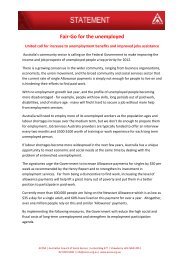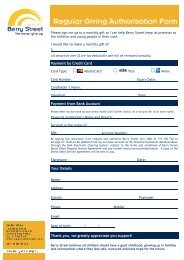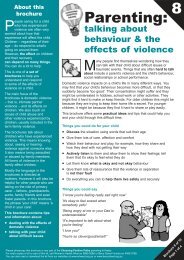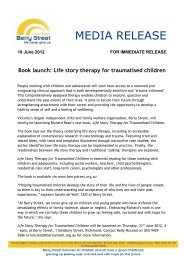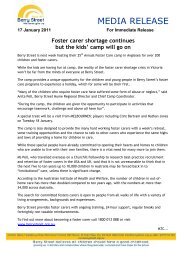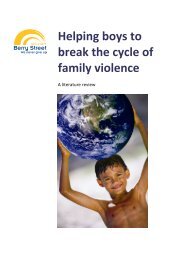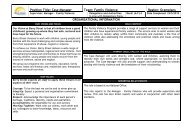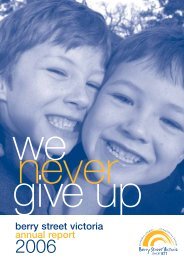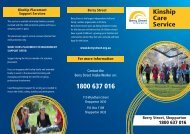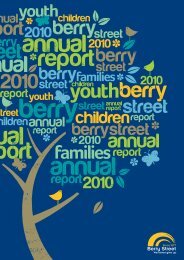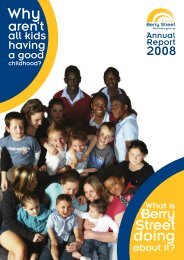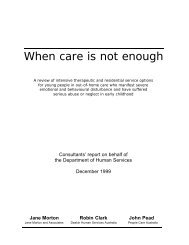Take Two - Third Evaluation Report More than Words ... - Berry Street
Take Two - Third Evaluation Report More than Words ... - Berry Street
Take Two - Third Evaluation Report More than Words ... - Berry Street
Create successful ePaper yourself
Turn your PDF publications into a flip-book with our unique Google optimized e-Paper software.
CYPP due to changes made in the new DHS Client<br />
Relationship Information System (CRIS) 3 . For example,<br />
the original HCA document was designed by <strong>Take</strong> <strong>Two</strong><br />
and SoPac Solutions (a computer software company)<br />
to enable data to be electronically imported into a<br />
database. When the HCA was incorporated into CRIS,<br />
this importing capacity was inadvertently removed. This<br />
led to a much more time-consuming data collection<br />
process. This was exacerbated by problems within the<br />
<strong>Berry</strong> <strong>Street</strong> computer system which led to a loss of<br />
data, requiring data re-entry. As reported in the next<br />
chapter, a project has recently completed in partnership<br />
with DHS to upgrade the HCA which has resolved these<br />
data importation dif culties.<br />
Another area of newfound dif culty was some data<br />
errors occurring in the CRIS version of the CYPP<br />
document. This involved inaccuracies regarding<br />
placement and child protection history, leading to more<br />
time-consuming data entry and some documents not<br />
being able to be analysed. For example, some CYPP<br />
documents only reported placement history for the<br />
current episode of child protection involvement instead<br />
of the child’s overall placement history. CYPP documents<br />
with apparent unreliable data were excluded from<br />
analysis leading to increased missing data for some<br />
items. 4<br />
2.5 Data collection regarding Aboriginal<br />
children and the work of the Aboriginal<br />
team<br />
The Aboriginal team’s expressed interest in being<br />
further involved in the evaluation process provided<br />
an opportunity to more fully describe some important<br />
aspects of Aboriginal children’s social and emotional<br />
wellbeing and more accurately describe the work<br />
of the Aboriginal team. The increase in the staff<br />
establishment of the Aboriginal team also facilitated<br />
their ability to follow their interest and commitment<br />
to improving <strong>Take</strong> <strong>Two</strong>’s work with Aboriginal children<br />
and identifying that research may assist this endeavour.<br />
The research project funded by the Australian Institute<br />
for Aboriginal and Torres Strait Islander Studies<br />
(AIATSIS) regarding assessment of Aboriginal children<br />
built on and strengthened the partnership between La<br />
Trobe University, <strong>Take</strong> <strong>Two</strong> and VACCA to explore how<br />
to assess Aboriginal children’s social and emotional<br />
wellbeing. It enabled the appointment of an Aboriginal<br />
Research Of cer, Jane Harrison, who made a major<br />
contribution to <strong>Take</strong> <strong>Two</strong>’s ability to think about research<br />
for Aboriginal children.<br />
In describing the Aboriginal <strong>Take</strong> <strong>Two</strong> client group a<br />
detailed analysis of referral and other client data was<br />
undertaken as well as analysis of the <strong>Take</strong> <strong>Two</strong> ATSI<br />
Assessment Tools. The original purpose of these tools<br />
was to assist non-Aboriginal clinicians to explore aspects<br />
of the child’s cultural connection and knowledge,<br />
including the knowledge of those caring for the child.<br />
The purpose has since grown to include assessment for<br />
all Aboriginal children in <strong>Take</strong> <strong>Two</strong> and to eventually be<br />
able to measure whether or not changes have occurred.<br />
The ATSI Assessment Tool was initially developed in<br />
2005 by Shaun Coade and Les Corlett who brought<br />
10<br />
together their experience and cultural knowledge to<br />
create the tool which was then piloted in <strong>Take</strong> <strong>Two</strong>. This<br />
tool began to be used in 2006 and was later adapted to<br />
enable capacity to measure change (Coade & Corlett,<br />
2008). Earlier versions had more open-ended questions,<br />
whereas the latest version has a mixture of xed choice<br />
and open questions and is a semi-structured design.<br />
The development of this tool and preliminary data<br />
analysis is described in Chapter 5. The data include all<br />
ATSI Assessment Tools completed at the time of writing,<br />
rather <strong>than</strong> limiting them to a particular time period, so<br />
as to maximise the data available and as they are not<br />
being used at this stage as an outcome measure.<br />
Copies of the ATSI Assessment Tools are sent to the<br />
Aboriginal team to assist their consultation for non-<br />
Aboriginal staff. The Aboriginal team forward copies<br />
of the tools to the research team for data entry on to<br />
an SPSS data base for analysis, As the earlier versions<br />
of the ATSI Assessment Tools had more open-ended<br />
questions, the research team was required to do more<br />
coding when entering the data. For the purposes of<br />
data validity, these data were entered by one member<br />
of the team and then cross-checked by another. Areas<br />
of potential confusion were discussed with a member<br />
of the Aboriginal team or the clinician who completed<br />
the tool.<br />
The Aboriginal team agreed to complete a timein-motion<br />
activity log for a week, with some team<br />
members completing the log for longer. These data<br />
enabled a more detailed exploration of the ‘day in the<br />
life of’ members of the Aboriginal team in their clinical<br />
and community work.<br />
Another aspect of the work of the <strong>Take</strong> <strong>Two</strong> Aboriginal<br />
team was the training and community intervention<br />
approach referred to as Yarning up on Trauma. Data<br />
for this analysis included reviewing the feedback<br />
surveys routinely requested by participants attending<br />
the training. These surveys are completed at the end<br />
of each day of the workshops and include the following<br />
questions: ‘Was the training helpful to you in your<br />
work?’, ‘What was most helpful?’, ‘What was least<br />
helpful?’, ‘What thoughts and feelings will you take<br />
away from this training?’, ‘How can we improve this<br />
training?’ and ‘Any other comments?’<br />
The recently published Yarning up on Trauma booklet<br />
(Coade, Downey, & McClung, 2008) describes the content<br />
of the training. The PowerPoint presentations and the<br />
participant’s handbook were also available for analysis.<br />
In late 2008 a member of the research team attended<br />
the training as a participant-observer. Finally, three of<br />
those involved in the development of the package were<br />
interviewed for this evaluation: namely, Shaun Coade<br />
(Manager — Aboriginal Services Development, <strong>Take</strong><br />
<strong>Two</strong>); Lisa McClung (Senior Clinician, Aboriginal team,<br />
<strong>Take</strong> <strong>Two</strong>); and Chrisie Warren (Manager of Learning<br />
and Development, VACCA).<br />
2.6 Research circles<br />
A component of the original research methodology<br />
was to establish research circles in different parts of<br />
the state. Three ongoing research circles have been<br />
implemented and are analysed in this report. Research<br />
3 See Glossary for further description.<br />
4 All dif culties identi ed with the accuracy of the data were raised with DHS as part of their quality improvement processes within the CRIS<br />
project.<br />
Frederico, Jackson, & Black (2010) “<strong>More</strong> <strong>than</strong> <strong>Words</strong>” – <strong>Take</strong> <strong>Two</strong> <strong>Third</strong> <strong>Evaluation</strong> <strong>Report</strong>, La Trobe University, Bundoora, Australia



